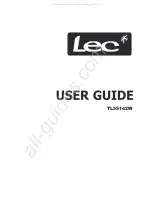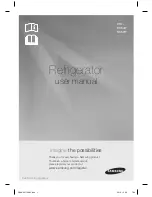
13
To help you make the most of the freezing process, here are some important hints:
•
The freezing process takes 24hrs. No further food to be frozen should be added during this period.
•
Only freeze top quality, fresh, and thoroughly cleaned foodstuffs.
•
Prepared food in small portions to allow it to be rapidly and completely frozen and to make it possible to
only thaw only the quantity required.
•
Wrap up the foodstuff in aluminum foil or polythene and make sure that the packages are airtight; do not
allow fresh and unfrozen food to touch already frozen food, thus avoiding a rise in temperature of the latter.
•
Lean foods store better and longer than fatty ones; salt reduces the storage life of food.
•
Water ice, if consumed immediately after removal from the freezer compartment, can cause frost burns.
•
It is advisable to show the freezing date in each individual item to keep a tab of the storage time and to
allow the removal of the item from the freezer compartment in a timely manner.
Tips for storage of frozen food
To obtain the best performance from this appliance, you should make sure that the retailer adequately stored the
commercially frozen foodstuffs. Be sure that the frozen foodstuffs are transferred to the freezer in the shortest
possible time.
•
Do not open the door frequently or leave it open longer than necessary.
•
Once defrosted, food deteriorates rapidly and cannot be frozen.
•
Do not exceed the storage period indicated by the food manufacturer.
Tips for fresh food refrigeration
To obtain the best performance:
•
Do not store warm food or evaporating liquids in the refrigerator.
•
Cover or wrap the food, particularly if it has a strong flavor.
Tips for refrigeration
Useful tips:
•
Wrap foodstuff in the polythene bags and place it on the glass shelf above the vegetable drawer.
•
For safety, store in this way only one or two days at the most.
•
Cooked foods, cold dishes, etc. should be covered and may be placed on any shelf.
•
Fruits and vegetables should be thoroughly cleaned and placed in the special drawer(s) provided.
•
Butter and cheese should be placed in special airtight containers or wrapped in aluminum foil or polythene
bags to exclude as much air as possible.
•
Milk bottles should have a cap and should be stored on the racks on the door.
•
Bananas, potatoes, onions, and garlic, if not packed, can be kept out of the refrigerator.
Cleaning
For hygienic reasons the appliance interior, including interior accessories, should be cleaned regularly.
Caution!
The appliance may not be connected to the main power supply during cleaning. Danger of electrical
shock! Before cleaning the appliance, switch the appliance off and remove the plug from the outlet, or switch off or
remove the circuit breaker or fuse. Never clean the appliance with a steam cleaner. Moisture could accumulate in electrical
components, the danger of electrical shock! Hot vapors can lead to damage of plastic parts. The appliance must be dry
before it is placed back into service.
Important!
Ethereal oils and organic solvents can attack plastic parts, e.g., lemon juice, juice from orange peels, butyric acid, or
cleansers that contain acid.
•
Do not allow such substances to come into contact with the appliance’s parts.
•
Do not use abrasive cleaners.
•
Remove items from the freezer and store them in a cool, covered area.
•
Switch the appliance off and unplug the unit or turn off the circuit breaker fuse.
•
Clean the appliance and interior accessories with a cloth and lukewarm water. After cleaning, wipe with fresh water
and rub dry.
•
After the appliance is dry, plug it into the main power supply. Then, you may use the appliance.




































